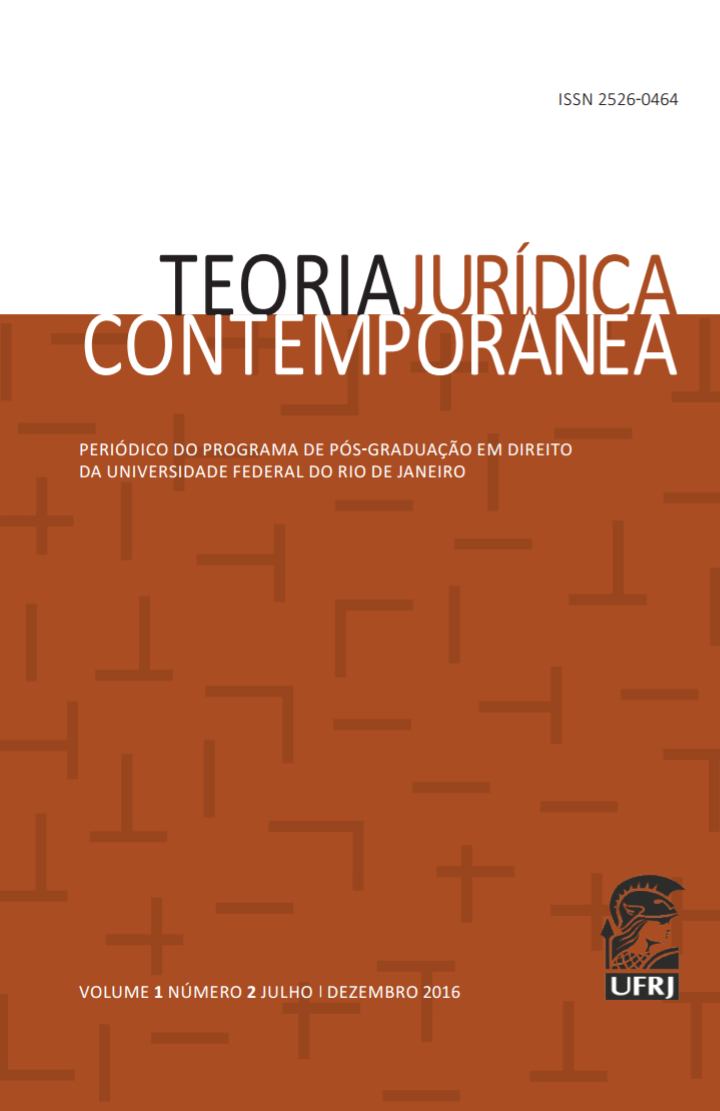Uma introdução à doutrina dos precedentes vinculantes e obrigatórios
DOI:
https://doi.org/10.21875/tjc.v1i2.8714Keywords:
Precedentes vinculantes, Segurança Jurídica, Jurisdição constitucional, Coerência, Poder Judiciário, Binding Precedent, Certainty in Law, Coherence, Judicial BranchAbstract
RESUMO:
O presente artigo busca apresentar a doutrina dos precedentes vinculantes e obrigatórios como novo paradigma a ser pensado nos Estados Constitucionais democráticos que têm em seu Poder Judiciário novo locus de criação e ressignificação dos direitos humanos e fundamentais quando do julgamento dos casos constitucionais difíceis. Apresenta a doutrina dos precedentes vinculantes, presente nos países do common law, que nunca tiveram a ilusão de que os limites do intérprete estariam contidos no próprio texto normativo, mas para verificar de que modo a mesma foi pensada a dar coerência e segurança jurídica ao sistema. Pretendeu-se, sob o método de pesquisa bibliográfica comparada enfrentar temas relativos à força vinculante dos precedentes, quer seja do ponto de vista horizontal ou vertical, a distinção entre precedentes persuasivos e vinculantes, bem como a possibilidade de erro no julgamento a justificar sua superação ou manutenção. Por outro lado, também apresentou a distinção entre seguir um precedente pelo fato dele ser um precedente ou pela experiência conhecida a partir do mesmo, bem como expôs as possíveis justificativas para o uso dos precedentes, como coerência, uniformidade do direito, segurança jurídica, eficiência e celeridade do Poder Judiciário.
ABSTRACT:
This article aims to analyze the doctrine of binding precedent as a new paradigm to be thought in the constitutional and democratic States, that have their judicial branch a new locus of creation and reinterpretation of human and fundamental rights when judging the difficult constitutional cases. The article also presents the doctrine of binding precedent, as in common law countries, who have never had the illusion that the interpretation of Law has limits in the normative text itself, but to know how the system was thought to provide consistency and legal certainty. This article uses comparative constitutional literature to tackle issues relating to the binding force of precedents, either horizontal or vertical, the distinction between persuasive and binding precedents, and the possibility of error in judgment to justify its overruling or maintenance. On the other hand, it examines the distinction between following a precedent because it is a precedent or because of a known experience and exposed the justifications for the use of the binding precedents, such as consistency, uniformity of law, legal certainty and efficiency.
Downloads
References
AKANMIDU, Raphael A. The Morality of Precedent in Law, Ratio Juris, v. 14, n. 2, jun. 2001.
BANKOWSKI, Zenon; et al. Rationales for Precedent. In: Mac CORMICK, Neil; SUMMER, Robert S. (Ed.). Interpreting Precedents: a comparative study. Ashgate: Hants, 1997.
BISHOP, Joel Prentiss. Common law and Codification or The Common law as a system of Reasoning -- How and Why essential to good government; what its perils, and how averted. Chicago: Law Book Publishers, 1888.
CROSS, Rupert; HARRIS, J.W. Precedent in English Law. 4 ed. New York: Oxford University Press, 2004.
DUXBURY, Neil. The authority of precedent: two problems. Legal Theory Workshop Series. Faculty of Law. University of Toronto, 2005.
DWORKIN. A Justiça de Toga. São Paulo: Martins Fontes, 2006.
EVANS, Jim. Change in the doctrine of precedent during the nineteenth century. In: GOLDSTEIN, Laurence. Precedent in Law, Ed. New York: Oxford University Press, 1987.
GOODHART, Arthur L. Determining the Ratio decidendi of a Case. The Yale Law Journal, v. 40, n. 2, dez. 1930, p. 161. Disponível em: <http://www.jstor.org/stable/790205>. Acesso em: 15 jan. 2009.
GOODHART, Arthur L. Precedent in English and Continental Law, Law Quarterly Review, n. 50.
HEALY, Thomas, Stare decisis and the Constitution: Four Questions and Answers. Notre Dame Law Review, v. 83, 2008; Seton Hall Public Law Research Paper No. 1019558. Disponível em: SSRN: <http://ssrn.com/abstract=1019558>. Acesso em: 29 dez. 2010.
HERSHOVITZ, Scott. Integrity and Stare decisis. In: HERSHOVITZ, Scott. (Ed.). Exploring Law's Empire. New York: Oxford University Press, 2008.
LEGARRE, Santiago; RIVERA, Julio César. Naturaleza y dimensiones del ‘stare decisis'. Revista Chilena de Derecho, v. 33 n.1, 2006.
MACCORMICK, D. Neil; SUMMERS, Robert S. Interpreting Precedents: a comparative study. England: Dartmouth, 1997.
MARTIN, Elizabeth A. (Ed.) A Dictionary of Law. 5. ed. New York: Oxford University Press, 2003.
PLUCKNETT, Theodore. A concise history of the common law. 5. ed. New Jersey: The Lawbook Exchange, 2001.
SCHAUER, Frederick. Precedent. Stanford Law Review, v. 39, n. 3, fev. 1987, p. 572. Disponível em: <http://www.jstor.org/stable/1228760>. Acesso em: 18 dez. 2008.
SELLERS, Mortimer Newlin Stead. The Doctrine of Precedent in the United States of America (September 3, 2008), p. 1. American Journal of Comparative Law, v. 54, n. 1, 2006. Disponível em: SSRN: <http://ssrn.com/abstract=1262933>. Acesso em 15 dez. 2009.
The doctrine of the individual binding precedent, 1934
VIEIRA, Andréia Costa. Civil law e Common law: os dois grandes sistemas legais comparados. Porto Alegre: Sérgio Antonio Fabris, 2007, p. 115
WALTERS, Mark. Legal Humanism and Law-as-integrity. Cambridge Law Journal 67 (2) July 2008, p. 364.
Downloads
Additional Files
Published
Issue
Section
License
The authors who publish in this journal agree with the following terms:
1. The authors maintain the copyright and grant the journal the right of first publication, with the work simultaneously licensed under the Creative Commons Attribution License that allows the sharing of the work with recognition of authorship and initial publication in this journal.
2. Authors are allowed to assume additional contracts separately, for non-exclusive distribution of the version of the work published in this journal (e.g., publishing in an institutional repository or as a book chapter), with acknowledgment of authorship and initial publication in this journal.
3. Authors are allowed and encouraged to publish and distribute their work online (e.g., in institutional repositories or as a personal page) at any point before or during the editorial process, as this may generate productive changes, as well as increase the impact and citation of the published work (See The Effect of Open Access).

This work is licensed under a Creative Commons Attribution-ShareAlike 3.0 Brazil License.

